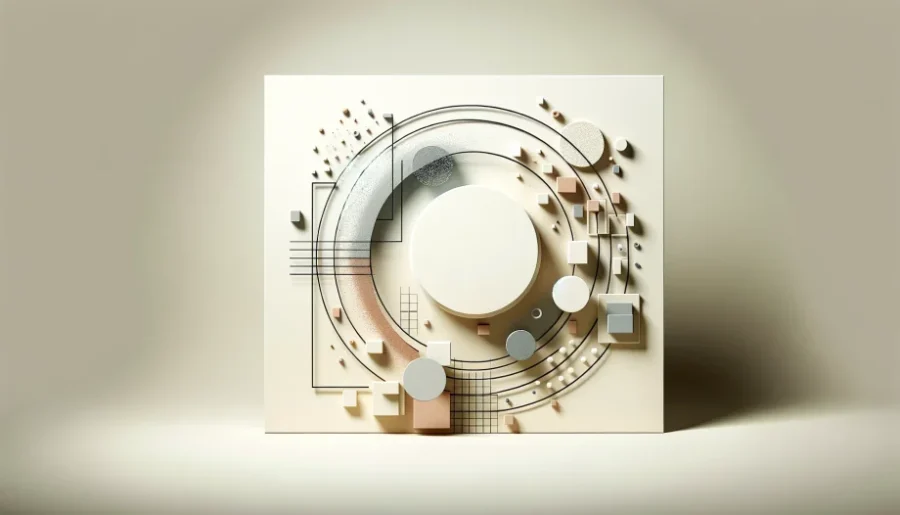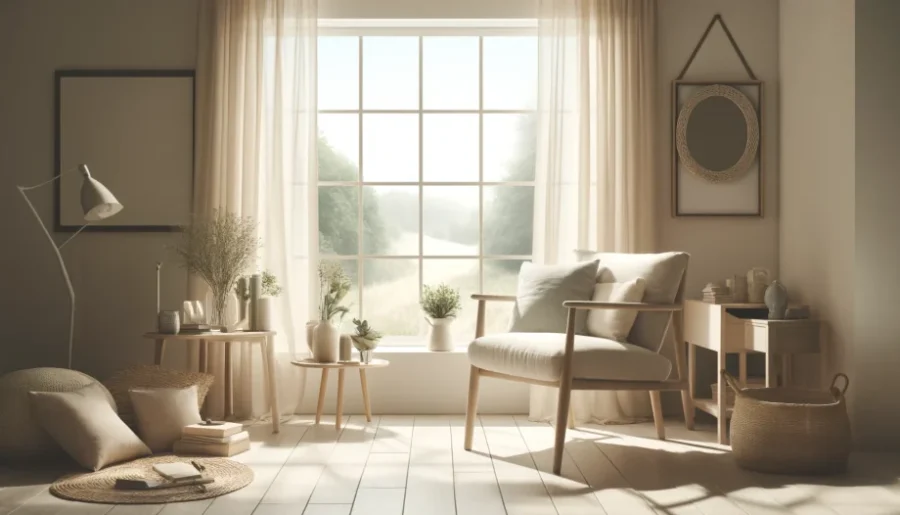
Drowning in stuff and don’t know where to start? Our minimalist decluttering tips will help you simplify your space and your life.
Discover how cutting down on clutter can refresh your home and renew your mind.
The Art of Minimalist Declustering
Howdy everyone! Dive into the minimalist way of decluttering—it’s not just about tidying up, it’s a whole new way to look at your space and your stuff.
By stripping down to the essentials, you clear out the clutter and pave the way for a more sustainable and thoughtful way of living.
Ready to get started? Here’s how you can kick off your minimalist journey.
24 Minimalist Decluttering Tips
Here are 24 decluttering tips to get you started and don’t forget to check out our Decluttering Your Home Checklist
1. Declutter Every Day
Make decluttering a daily habit. Even a few minutes each day can keep clutter from piling up, reducing stress and promoting a serene home environment.
2. Build a Capsule Wardrobe
Simplify your clothing choices with a capsule wardrobe. This encourages buying fewer, better-quality pieces that last longer, saving resources and reducing waste.
3. Buy Less
Emphasize the importance of purchasing less to minimize waste. Each item you don’t buy is one less item that might end up in a landfill.
4. Consider Quality Over Quantity
Invest in high-quality items that last longer. Although they might cost more upfront, their longevity means you purchase less over time, benefiting your budget and the planet.
5. Get Rid of Excess Clutter
Identify and remove items you no longer use or need. This can free up space, decrease anxiety, and lead to a more organized life.
6. Set a Decluttering Schedule
Organize decluttering sessions on your calendar. Regular, planned decluttering reduces the buildup of unused items and maintains a minimalist home.
7. Clutter-Free Habits
Develop habits that prevent clutter from accumulating. Simple actions like sorting mail daily can keep your spaces neat and tidy.
8. Decluttering Is an Emotional Process
Acknowledge that decluttering can be emotionally challenging and provide strategies for letting go of items with sentimental value.
9. Give One Item Away Each Day
Implement a daily giveaway to slowly reduce possessions. This habit can reinforce generous behaviors and reduce environmental impact.
10. Choose Sustainable Items
When purchasing new items, opt for sustainable materials. This supports eco-friendly practices and reduces environmental degradation.
11. Pick a Shelf
Start small by decluttering just one shelf. This manageable task can motivate you to tackle larger areas.
12. Start by Changing Your Mindset
Shift your thinking to see less as more. This mental change is crucial for embracing minimalism in all aspects of life.
13. Start Small
Begin with small, manageable decluttering tasks to avoid feeling overwhelmed. This makes the process more approachable and less daunting.
14. Start with Yourself
Focus on decluttering your own items before attempting to declutter shared spaces or others’ belongings.
15. Stick to the 3-Month Rule
If you haven’t used an item in three months, consider letting it go. This rule helps clear out items that are not truly necessary.
16. Build a Budget
Create a budget that prioritizes needs over wants. This financial discipline supports minimalistic living by curbing excessive spending.
17. Create Designated Spaces
Assign a specific place for everything in your home. This organization minimizes clutter and simplifies cleaning.
18. Donate
Donate items you no longer need. This not only clears your space but also helps those in need and supports recycling efforts.
19. Fill an Entire Trash Bag
Challenge yourself to fill a trash bag with items to discard or donate as quickly as possible. This can be an effective and satisfying way to declutter.
20. Focus on Experiences
Shift focus from material goods to experiences. Investing in experiences rather than things can lead to greater happiness and less clutter.
21. Get Rid of Duplicates
Eliminate duplicate items. Keeping only the essentials reduces clutter and simplifies decision-making.
22. Green is Something You Do
Adopt eco-friendly habits in everyday life, such as recycling or choosing eco-friendly products. This aligns with the minimalist ethos of reducing waste.
23. Make the Most of 15 Minutes
Use short bursts of decluttering to make progress without becoming overwhelmed. Even 15 minutes can make a significant difference.
24. Name Your Categories and Define Zones
Organize items by category and designate specific zones for storing them. This systematizes your possessions and simplifies maintenance.
Declutter Your Home Checklist: Simplify Like a Minimalist

Declutter Your Home Checklist: Your Guide to a Simpler Space
Hey there, fellow green thumbs and simplicity seekers! Whether you’re looking to tidy up a bit or dive deep into a full minimalist makeover, this checklist is your first step towards a clearer, more serene home.
Let’s roll up our sleeves and start decluttering, one item at a time. Ready to transform your space? Let’s get into it!
1. Begin with the Basics Start your decluttering journey in a manageable area. Choosing a small, defined space, like a single drawer or closet, can boost your confidence and set the stage for larger tasks.
2. Make It a Daily Ritual Incorporate decluttering into your daily routine. Consistently clearing out even just a few items each day keeps clutter under control and reinforces your minimalist lifestyle.
3. Target Clutter Hotspots Identify and focus on areas that tend to accumulate clutter quickly, such as kitchen countertops, entryways, and living room surfaces. Keeping these areas clear can transform the feel of your home.
4. Question Everything When sorting through your belongings, critically assess each item’s purpose and place in your home. This helps decide whether it stays or goes.
5. Purge Unwanted Items Actively remove items you no longer love or need. Donating clothes, books, and other goods can free up space and benefit others.
6. Optimize Storage Solutions Utilize smart storage solutions to maintain organization. Tools like over-the-door organizers or under-bed boxes can cleverly hide essentials while keeping them accessible.
7. Prioritize Lasting Quality When purchasing new items, choose quality over quantity. Investing in durable, timeless pieces reduces the need for frequent replacements and lessens waste.
8. Cultivate a Capsule Wardrobe Embrace the concept of a capsule wardrobe, which limits the number of clothes you own but maximizes their functionality. This approach not only declutters your closet but also simplifies daily dressing decisions.
FAQs: Understanding Minimalist Decluttering
Tackling your clutter with a minimalist mindset might have you scratching your head with a few questions, especially when you’re trying to stick to all those rules and strategies. No worries!
Below, I’ve rounded up some of the most common questions to help clear up any confusion and make your path to a clutter-free and purposeful space a whole lot smoother.
Let’s get those questions answered!
Q: What is the 20/20 rule for decluttering?
A: The 20/20 rule suggests that if you can replace an item for less than $20 in less than 20 minutes, it’s safe to discard.
This guideline is particularly useful for reducing hesitation over getting rid of seldom-used items, helping to streamline decisions and minimize clutter.
Q: What is the 90/90 rule for minimalism?
A: The 90/90 rule, often used in minimalist practices, advises that if you haven’t used an item in the last 90 days and don’t plan to use it in the next 90 days, consider letting it go. This rule helps identify and eliminate unnecessary belongings that don’t add value to your life.
Q: How to declutter and be a minimalist?
A: To declutter and adopt a minimalist lifestyle, start by setting clear goals for your space and possessions. Focus on keeping only what serves a purpose or brings joy.
Regularly assess your belongings, declutter incrementally, and resist the urge to accumulate non-essential items. Emphasize quality over quantity and strive for simplicity in all areas of your home.
Q: What is the 20 rule minimalist?
A: The 20 rule in minimalism, often referred to as a variant of the 20/20 rule, encourages reducing belongings to only what’s essential. The goal is to prioritize the quality and utility of items rather than quantity, ensuring each item has a functional or sentimental purpose.
Q: What is the 80-20 rule for clutter?
A: The 80-20 rule, or Pareto Principle, applied to decluttering suggests that we typically use only 20% of our belongings 80% of the time.
By identifying and focusing on those key items, you can drastically reduce clutter by letting go of the 80% that is less frequently used.
Q: How can I make decluttering decisions easier?
A: To simplify decluttering decisions, create personal rules based on your habits and needs. For example, if you rarely use dry-clean-only clothing, decide to declutter them to reduce decision fatigue and keep only what suits your lifestyle.
Q: What should I do with items I’m unsure about keeping?
A: Place items you’re unsure about in a “maybe” pile. This approach allows you to defer the decision without cluttering your space, giving you time to assess their value in your life before making a final decision.
Q: Is there a fun way to approach decluttering?
A: Yes, gamifying the decluttering process can make it more engaging. Consider setting up a decluttering bingo or challenge with friends or family to make the task more enjoyable and maintain motivation.
Q: How does minimalism differ from just decluttering?
A: Minimalism is not just about removing excess items; it’s a lifestyle choice that emphasizes living with less to focus more on what brings joy and value.
Unlike basic decluttering, which may only temporarily clear spaces, minimalism encourages a long-term commitment to reducing possessions.
These FAQs should help provide clearer guidance on how to integrate minimalist principles into your decluttering efforts effectively.
Conclusion: Embracing Minimalism for a Sustainable Future
Hey there! As we wrap up our deep dive into minimalist decluttering, it’s clear that this isn’t just about having a tidy home—it’s about setting the stage for a more sustainable and fulfilling life.
By choosing minimalism, you’re not only clearing out your physical space, you’re also making room for more joy, creativity, and less stress in your life.
Let’s recap some of the key takeaways and consider how these changes can pave the way for a brighter, greener future.
Key Takeaways:
- Less Is More: Embracing fewer possessions can lead to more freedom and less stress. By keeping only what you truly need and love, you enhance your daily living experience.
- Quality Over Quantity: Investing in high-quality items that last longer not only saves you money in the long run but also reduces waste, supporting a more sustainable lifestyle.
- Mindful Consumption: Minimalism encourages us to think before we buy, which can dramatically reduce unnecessary purchases and help us focus on what’s truly important.
- Enhanced Focus and Creativity: With less clutter to distract you, your mind is freer to focus on creative pursuits and personal growth.
- Environmental Impact: Reducing what we consume and how much waste we produce is a big step toward a healthier planet. By decluttering responsibly and choosing sustainably, we can all make a difference.
Simplify Your Home for Greater Happiness
By making mindful decisions about what we keep in our lives and why, we not only improve our own living spaces but also contribute to a larger cultural shift towards sustainability.
Remember, every small step toward minimalism is a step towards a cleaner, greener, and more sustainable future.
Let’s keep pushing the boundaries of what it means to live simply and sustainably.
Thanks for joining me on this journey, and here’s to your minimalist adventure!
Read and learn more: Minimalism and Sustainability: 20 Simplified Tips
Resources: A Deeper Dive into Minimalist Decluttering
If you’re on the lookout for some solid gold resources to help you embrace that sweet, simple, and clutter-free life, here’s a roundup of some websites packed with articles on minimalist decluttering tips.
These gems are just the ticket for anyone keen to learn more about paring down to the essentials!
- Becoming Minimalist – Dive into a wealth of strategies to reduce your belongings and maintain a minimalist home. This site offers practical advice on how to declutter your home and sustain a minimalist lifestyle. Get started on your decluttering journey with their array of articles at Becoming Minimalist.
- The Minimalist Vegan – Looking for a comprehensive checklist to help you declutter? The Minimalist Vegan has an extensive list of ideas to pare down various areas of your life, making it a great starting point for those new to minimalism. Check out their decluttering checklist and more at The Minimalist Vegan.
- Simply + Fiercely – Simply + Fiercely offers insightful articles on minimalist living with practical tips that are easy to apply. Their content encourages you to ask the right questions about your possessions to determine their value in your life. Find guidance to refine your lifestyle at Simply + Fiercely.
- Green With Less – For those who need straightforward, actionable tips on decluttering, Green With Less provides hacks and mental shifts to help you embrace minimalist living. Their content is geared towards making decluttering approachable and manageable. Explore their tips at Green With Less.
These websites are fantastic resources for anyone looking to dive deeper into the world of minimalism and decluttering.
Whether you’re just starting out or looking for new strategies to enhance your minimalist journey, these sites have got you covered!




